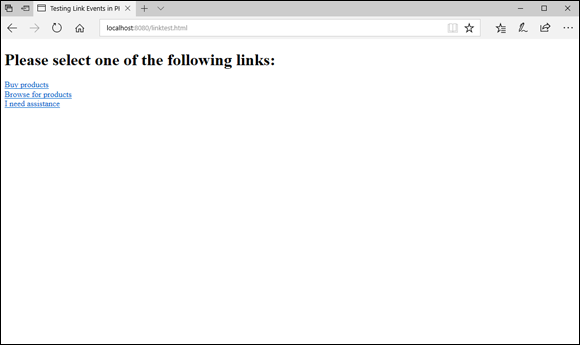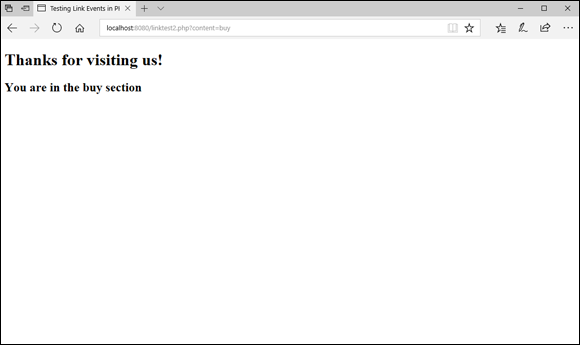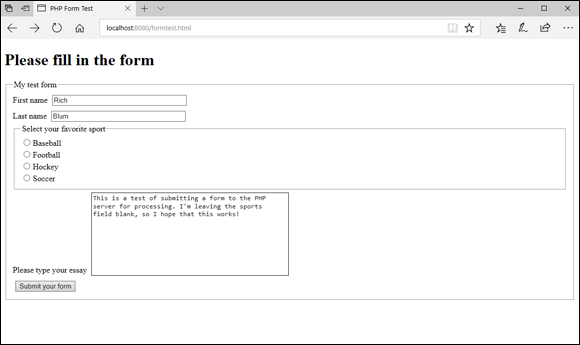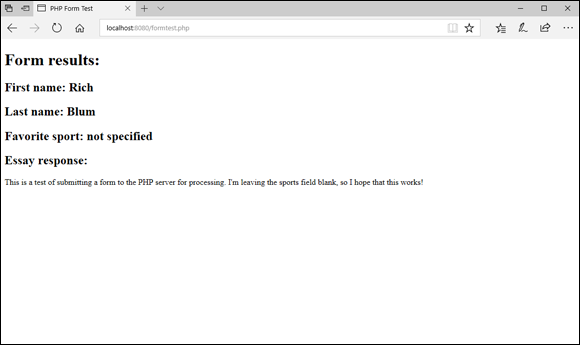Because PHP is a server-side programming language, you can't associate it directly with events that occur within the browser. However, that said, you can link your PHP web pages to specific events in the web page so that the browser can request a specific web page based on an event.
The following sections describe how to use each of these event-driven methods to launch your PHP web pages.
Working with links
In HTML5, you create hypertext links on the web page using the anchor element:
<a href="mypage.html">Click here</a>
The text Click Here appears on the web page, and when the site visitor clicks that link, the browser requests the mypage.html file from the web server.
You can use this method for passing small amounts of data to the PHP web pages in your web application. As part of the URL, you can embed variable/value pairs after the URL location that get passed to the web server:
<a href="mystore.php?content=store">Click to shop</a>
The browser sends the data combination of content and store to the web server as part of the GET request for the new web page. If you need to send more data, separate them with the ampersand sign:
href="mystore.php?content=buy&prodid=10"
This link sends two variable/value pairs to the web server using the GET method:
content=buy
prodid=10
To retrieve the data values passed using the GET method in your PHP code, use the special array variable $_GET[]. The PHP server populates the $_GET[] array variable with all the variable/value pairs passed in the GET method from the client browser. You can then access those array variables in your PHP program code.
Follow this example to test out using the GET method to pass data from a link click event to a PHP program:
- Open your editor and enter the following code:
<!DOCTYPE html>
<html>
<head>
<title>Testing Link Events in PHP</title>
</head>
<body>
<h1>Please select one of the following links:</h1>
<a href="linktest2.php?content=buy">Buy products</a><br>
<a href="linktest2.php?content=browse">Browse for products</a><br>
<a href="linktest2.php?content=help">I need assistance</a><br>
</body>
</html>
- Save the file as
linktest.html in the DocumentRoot folder for your web server.
- Open a new window in your editor and enter the following code:
<!DOCTYPE html>
<html>
<head>
<title>Testing Link Events in PHP</title>
</head>
<body>
<h1>Thanks for visiting us!<h1>
<?php
$content = $_GET['content'];
echo "<h2>You are in the $content section</h2>\n";
?>
</body>
</html>
- Save the file as
linktest2.php in the DocumentRoot folder for your web server.
- Ensure that the web server is running, and then open your browser and enter the following URL:
http://localhost:8080/linktest.html
- Click one of the links on the web page, and observe what appears in the resulting web page.
- Close the browser when you're done.
When you open the linktest.html web page, you’ll see a series of links that simulate a navigation menu bar in a web page. Each link consists of a hyptertext link that points to the same web page (linktest2.php) but sets a different value for the content variable passed in the GET method. When you open the page, you should see the results, as shown in Figure 2-5.
When you click a link on the web page, the browser sends a GET request to the web server for the specified web page file, and passes the content variable setting assigned in the anchor element tag.
When the Apache web server receives the GET request from the client browser, it retrieves the linktest2.php file, and because it uses the .php file extension, it passes it to the PHP server to process the embedded PHP code. The PHP server detects the GET variable/value pair passed and assigns it to the $_GET[] array variable. The code in the linktest2.php code retrieves that value from the $_GET[] array variable and assigns it to another variable:
$content = $_GET['content'];
The code then uses that variable in the echo statement to display on the web page. The result is shown in Figure 2-6.
 Notice the URL that appears in the address bar in the
Notice the URL that appears in the address bar in the link2test.php web page. It contains the content variable, along with the value that was set by the anchor element href attribute. Because the values set using the GET method appear in the URL, they aren't a secure method of sending data. You should limit using the GET method to passing data about web pages and not personal information.
Processing form data
Book 2, Chapter 3, discusses how to build data entry forms using HTML5 code. To refresh your memory, the core of the HTML5 form is the <form> tag. This tag defines the beginning and end of the data fields that make up the form. The <form> tag uses three main attributes:
name: Specifies a unique name for the formmethod: Specifies the HTTP method used to pass dataaction: Specifies the web page to pass the form data to
Within the form element, you include HTML elements for text boxes, text areas, radio buttons, check boxes, and other HTML5 form data fields. Each element uses a unique name to identify it in the form data that the browser sends to the action web page.
Because PHP runs on the server, it has no way of knowing when the site visitor is done filling out the form data fields in the browser window. With PHP, it's imperative to have a Submit button in the form to indicate to the browser when to send the form data to the web page specified in the action attribute, using the method specified in the method attribute.
A simple HTML5 form to use with PHP would look like this:
<form name="myform" action="mypage.php" method="POST">
<label>First name</label>
<input type="text" name="fname" size="40"><br>
<label>Last name</label>
<input type="text" name="lname" size="40"><br>
<input type="submit">
</form>
After the site visitor fills in the form data, she needs to click the Submit button to send the data to the mypage.php file specified in the form action attribute. The browser sends the form data embedded behind the scenes in the HTTP communication with the web server.
In the receiving web server, it passes the data received by the POST method to the PHP server, which uses the special $_POST[] array variable to retrieve the form data. You can then access that data in your PHP code using the $_POST[] array variable, along with the form field names:
$firstname = $_POST['fname'];
$lastname = $_POST['lname'];
The same method works for retrieving data from a <textarea> form field.
To retrieve the value from a select element, the name attribute of the select element defines the field name, and the option element value attribute for the option selected in the field is the value passed in the POST data. Consider the following form field:
<select name="age">
<option value="young">18-35</option>
<option value="middleage'>36-55</option>
<option value="old">56+</option>
</select>
When the site visitor selects the option labeled 18-35 in the drop-down list, the form sends the value young in the POST data. The PHP code can then access the $_POST['age'] array variable to retrieve the selected value.
To retrieve the value from a radio button element, the name attribute for all the buttons in the same group is the same. The value attribute defines what data is sent to the server as part of the POST data:
<input type="radio" name="age" value="young">18-35
<input type="radio" name="age" value="middleage">36-55
<input type="radio" name="age" value="old">56+
The PHP code checks the $_POST['age'] variable for the data value passed by the selected radio button.
Working with check box data fields can be a little tricky. The check box doesn't pass any data — it just indicates whether the box is checked. If the box is checked, it sends the value specified by the value attribute assigned to the data field specified name attribute:
<input type="checkbox" name="age" value="old">
If the site visitor checks the box in the form, the form sends the data field age with a value of old, and your PHP code can retrieve the selection using the $_POST['age'] array variable.
The problem comes in if the site visitor doesn't select the check box. If the check box is not selected, the form doesn’t send any data for the form field. In that case, if you try using the $_POST['age'] array variable, you get an error from PHP that it doesn’t exist.
To determine if a check box form field has been selected, you use the isset() PHP function. The isset() function returns a TRUE value if the PHP variable exists and has a value assigned to it or a FALSE value if not. You can then write something like this:
if (isset($_POST['age'])) {
$age = $_POST['age'];
} else
$age = "not selected";
}
Now you're able to determine whether the site visitor selected the check box.
Working with forms and PHP can be a bit tricky, but the more you practice, the better you’ll get at it. Try out this example to get a feel for how to work with forms and PHP:
- Open your editor and type the following code:
<!DOCTYPE html>
<html>
<head>
<title>PHP Form Test</title>
<style>
input, textarea {
margin: 5px;
}
</style>
</head>
<body>
<h1>Please fill in the form</h1>
<form action="formtest.php" method="post">
<fieldset>
<legend>My test form</legend>
<label>First name</label>
<input type="text" name="fname" size="40"><br>
<label>Last name</label>
<input type="text" name="lname" size="40"><br>
<fieldset>
<legend>Select your favorite sport</legend>
<input type="radio" name="sport" value="baseball">Baseball<br>
<input type="radio" name="sport" value="football">Football<br>
<input type="radio" name="sport" value="hockey">Hockey<br>
<input type="radio" name="sport" value="soccer">Soccer<br>
</fieldset>
<label>Please type your essay</label>
<textarea name="essay" cols="50" rows="10"></textarea><br>
<input type="submit" value="Submit your form">
</fieldset>
</body>
</html>
- Save the file as
formtest.html in the DocumentRoot folder for your web server.
- Open a new window in your editor and type the following code:
<!DOCTYPE html>
<html>
<head>
<title>PHP Form Test</title>
</head>
<body>
<h1>Form results:</h1>
<?php
$fname = $_POST['fname'];
$lname = $_POST['lname'];
if (isset($_POST['sport'])) {
$sport = $_POST['sport'];
} else {
$sport = "not specified";
}
$essay = $_POST['essay'];
echo "<h2>First name: $fname</h2>\n";
echo "<h2>Last name: $lname</h2>\n";
echo "<h2>Favorite sport: $sport</h2>\n";
echo "<h2>Essay response:</h2>\n";
echo "<p>$essay</p>\n";
?>
</body>
</html>
- Save the file as
formtest.php in the DocumentRoot folder for your web server.
- Ensure the web server is running and then open your browser and enter the following URL:
http://localhost:8080/formtest.html
- Fill in the from data fields, selecting a radio button but leaving the check boxes all unchecked.
- Click the Submit button when you're done filling in the form.
- Close the browser and shut down the web server.
The formtest.html file displays a standard HTML5 form on the web page, as shown in Figure 2-7.
Enter your data in the form, but don't make a selection for your favorite sport. When you click the Submit button, the browser sends the form data as part of a POST method to the web server, which passes the form data to the formtest.php file as specified in the form action attribute.
The formtest.php code retrieves the form data and detects that none of the radio buttons was selected. By using the isset() function. It displays the data passed from the form, as shown in Figure 2-8.
Now you’re ready to process any HTML5 form using your PHP server-side programming skills!
 Adding conditional tests
Adding conditional tests Looping through code
Looping through code Building functions
Building functions Working with event-driven programming
Working with event-driven programming Notice that the comparison operator used to check if two values are equal is the double equal sign, not a single equal sign. Forgetting that small detail causes all sorts of annoying errors in your PHP code because the equal sign performs an assignment operation, which always returns a
Notice that the comparison operator used to check if two values are equal is the double equal sign, not a single equal sign. Forgetting that small detail causes all sorts of annoying errors in your PHP code because the equal sign performs an assignment operation, which always returns a 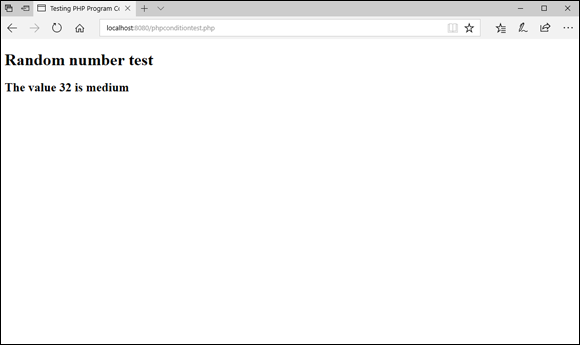
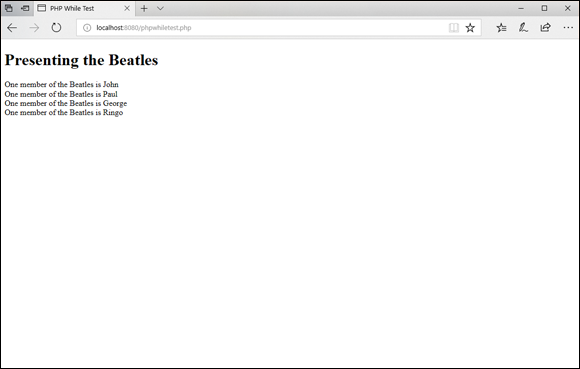
 An associative array uses text keys, not numbers, to track data values. There’s no way you can increment through the keys in an associative array variable using the
An associative array uses text keys, not numbers, to track data values. There’s no way you can increment through the keys in an associative array variable using the 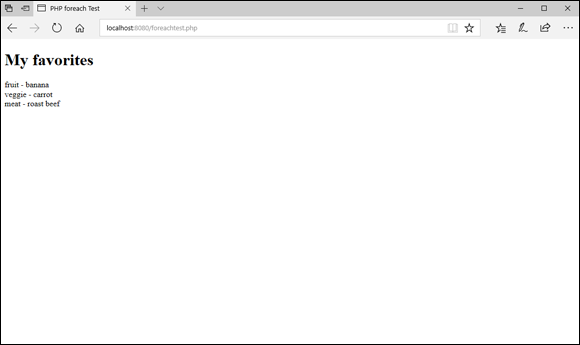
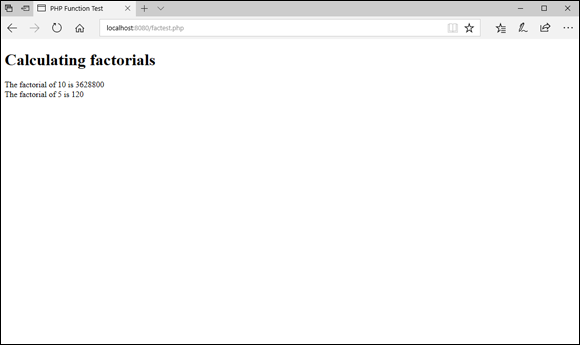
 If you have lots of functions that you use in many of your programs, you can define them in a separate file. Then to use the functions in your programs just use the
If you have lots of functions that you use in many of your programs, you can define them in a separate file. Then to use the functions in your programs just use the 